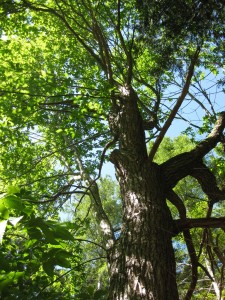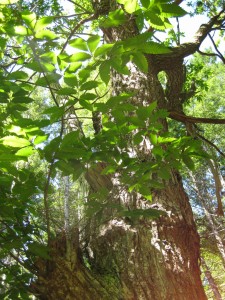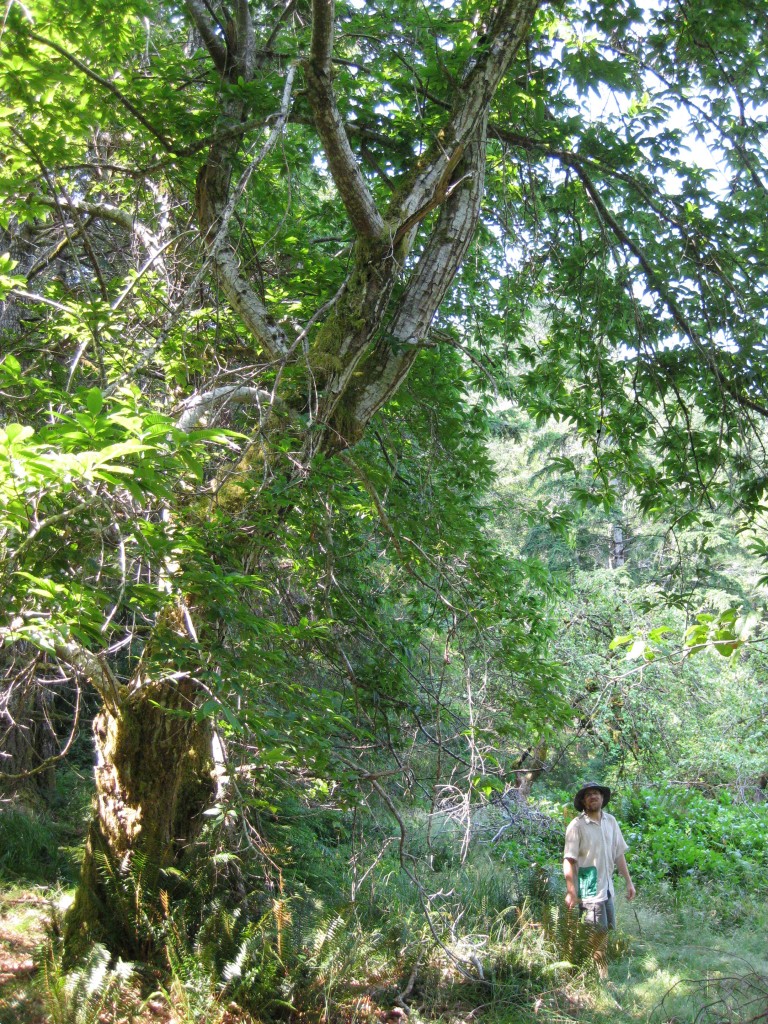an old chestnut
One of my earliest and most cherished childhood memories is of lying back on the rear seat of my parents’ thrumming Buick, never having known the restraint of a car seat or a safety belt and gazing up through the rear window as great leafy vaults of deciduous trees passed overhead, interspersed now and then by flashes of golden, late afternoon sunshine. I remember the sharp smell of the road dust and the orange glint of an oriole, clinging to its bag-like nest, high in an overhanging bough. For me, these childhood memories of shimmering tree tunnels are the archetype of summer; languid yet ephemeral and intensely poignant; all the more so knowing as I do that the trees and the bucolic dirt roads they overshadowed were obliterated by Toronto’s urban sprawl just a few years after I first experienced them. But even before the onslaught of cul de sacs and strip malls, the landscape of my childhood was changing. As I blissfully dozed on that vast bench seat, there were elm trees all around me getting silently infected by Dutch Elm disease. Within a decade or so their massive viridian canopies stood leafless and rattling against the Ontario sky like the withered tentacles of giant squids for whom the sea had suddenly drained away.
50 years before the great dying of the elms, an even more widespread and perhaps more consequential tree extirpation was underway. This was demise of the American Chestnut (Castanea dentata), once a key component of the hardwood forest zone that stretches from southern Ontario through the Appalachians into the American South. The American chestnut, which by some accounts comprised up to 25% of these predominantly deciduous forests, was almost completely extirpated by a fungal blight, mistakenly introduced to North America via the importation of a few Chinese chestnut (Castanea mollissima) trees to the Bronx. The disease spread virulently through the highly susceptible American species and within a few decades, millions had died, changing the character of the Eastern forests forever. Yet here and there a few clung to life, protected because they grew in places somehow inaccessible to the blight’s spores or because they had quirky genetics, which rendered them partial immune to the rampant epidemic. Since the peak of the blight, these genetically endowed survivors have been sought out by plant breeders who have been crossing them with Chinese chestnuts in the hopes of developing trees that combine the lofty growth of the American tree with the disease resistance of their compact Chinese parents. Progress has been slow but steady and the successful progeny of these breeding trials have been being planted in parks and arboretums for some years now, sponsered primarily by the American and Canadian Chestnut societies.
The loss of the American Chestnut was a colossal blow not only to the biodiversity of their habitat (their nuts were a key food source for the now extinct Passenger Pigeon) but to the human food supply as well. Chestnuts are similar in food value to grains and also contain significant quantities of Vitamin C yet they don’t need the intense inputs of energy and resources demanded every year by most cereal crops. Once trees are established, the only labor is to harvest nuts once a year and perhaps thin competing trees here and there to maintain the health of the grove. J. Russell Smith describes traditional European agroforestry systems base on chestnuts in his classic (1929) Tree Crops – A Permanent Agriculture; a book he wrote in response to the contemporaneous collapse of the American agriculture system at the start of the Great Depression. Smith extols the virtues of these perennial tree-based ‘permacultures’ and recounts a level of prosperity and leisure in the nut growing areas, unthinkable to the misery inflicted grain farmers of the Dust Bowl era. In addition to the market value of the nuts themselves, Smith describes the exceptional quality and desirability of the pork fattened on nuts left behind under the trees after the harvest. In this day and age, given the amount of arable land devoted to corn, which is in turn fed to cattle and pigs, it seems to make a lot sense to switch, at least partially, to animal food sourced from such sustainable, tree-based permacultures. This would also provide added benefits such as enhanced wildlife habitat, the protection of watersheds and carbon sequestration. A recent Purdue University study showed that the American Chestnut can store up to three times more carbon than other trees sharing its ecosystem, which against the backdrop of climate change gives us another compelling reason to reestablish chestnut over large areas.
Coastal British Columbia is far removed from the native range of the American Chestnut yet its European cousin (Castanea sativa) has been planted here occasionally and thrives, particularly in areas such as the Gulf Islands and the Lower Mainland, which have warmer summers. For years, I have been admiring a particularly stately tree that grows on the edge of my property in Whaletown on Cortes Island. I had always assumed it was a particularly large specimen of Castanea sativa yet there was something odd about the tree’s great height – over 60 feet. It seems to have no trouble completing for sun with the surrounding Douglas firs and Big-leaf maples and looks truly at home in its forest setting. The nuts it produces are tiny; less than 3/4 of an inch or so, which is much smaller than any commercially available eating chestnuts I have seen.
All of this made me wonder if I might all these years have been looking at an example of the elusive American chestnut – Castanea dentata. I figured the odds were pretty small, given that the European species is so prevalent in these parts but still my doubts persisted.
A couple of weeks ago, I finally got around to keying out the tree, using this helpful on-line guide (chestnut ID) put out by the Massachusetts Chapter of The American Chestnut Foundation, as well as this web site (more ID), which provides detailed photos of the leaves, twigs and nuts of all the chestnut species, for easy comparison. Surprisingly, my tree shows a lot of the characteristics of the American variety, yet I’m still not exactly certain. Chestnuts seem maddeningly difficult to identify, especially since hybridization is always a possibility.
A good portion of the older fruit trees on Cortes Island trace their provenance to a man by the name of Hayes, a former employee of the genius plant breeder Luther Burbank, who moved to these parts in the early days 20th century, so it is possible that the chestnut was one of Burbank’s (crosses). The tree seems to be about the right age, just shy of a hundred, given its substantial girth and height. The leaves of the tree are papery thin and extremely long; the longest one I measured coming in at almost 11 inches. The leaf edges are serrated by curved teeth ending in a single bristle in accordance with the descriptions for Castanea dentata. The twigs are smooth and supple, which also points to the American Chestnut. The vast majority of the nuts when they drop from the tree, shrivel, un-pollinated inside their sea urchin-like casings, but every year a few of them germinate in the leaf litter until, inevitably, they get browsed down by hungry deer. This year though, I have 5 or 6 of the seedlings in pots and I plan to grow more in the hopes of getting a grove going and to be able to distribute the seedlings to other nut enthusiasts. It’d be great to see whole forests of these magnificent trees get established, in blight-free areas of the West Coast, especially on large tracts of logged over land, ravaged by the forest industry.
I’ve attached a link to a Flickr photo set of the whole tree, the nut casings and the leaves as well as the leaves of another chestnut variety I purchased around ten years ago as C. sativa, for the purposes of comparison. If anyone can help me identify this magnificent tree, I would be most appreciative. Please do so via the comment feature of this blog and I’ll get right back to you. Thanks so much!







Your tree looks like Castanea dentata.
There are places you can send the samples for identification.
I would be interested in a few seedlings, have grown American chestnuts since 1983.
Some are over 50 feet tall and have “volunteers” growing below them, that the deer and mice overlooked. The trees do get the blight, a few seem to have a little resistancy.
[…] an old chestnut […]